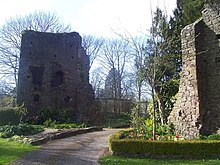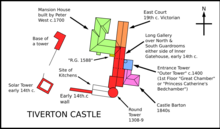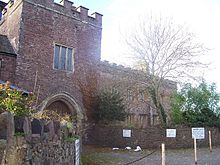Tiverton Castle
Tiverton Castle is a ruined castle and later country house on the banks of the River Exe in Tiverton in the English county of Devon . The castle was built in the Middle Ages and was demolished after the English Civil War . The country house was built in the 17th century.
description
Tiverton Castle was once much larger than it is today. A number of remains of the surrounding wall , the towers and the buildings from different periods have been preserved. The Norman motte was originally built in 1106 and then expanded and changed in the 12th and 13th centuries.
history
English Civil War
During the English Civil War, the castle was a royalist fortress. Fairfax's parliamentary troops besieged a royalist force in the castle, set up their headquarters at Blundell's School and stationed their artillery in the Skrink Hills (or Shrink Hills ) just above and below Cranmore Castle , about half a mile from Tiverton Castle. The field snake , the largest gun in the New Model Army , could fire up to 2000 yards (approx. 1800 meters). While the gunners were still firing into the castle, a lucky shot hit one of the chains of the drawbridge and a small group of roundheads were able to gain entry immediately. So the siege was actually over before it really started. The entire defenses were then destroyed by the parliamentary troops to prevent them from being used again in the war.
The most important source is the stories by John Rushworth (ca. 1612–1690), which are dated “Tiverton, October 19, 1645, nine o'clock” and whose title is: “The capture of Tiverton, with castle, church and fort , by Sir Thomas Fairfax on the Last Lord's Day, October 19, 1645. Colonel Sir Gilbert Talbot, the governor, was captured. Major Sadler, Major of Colonel Talbot. 20 officers worth mentioning. 200 common soldiers. Four members of the orderly. 500 weapons with ammunition storage, supplies and treasure. Also Goring inflicted several defeats by his Excellency and all Goring forces fled from him. Published by order. "The relevant passage reads as follows:
“Major General Massey soon took the town of Tiverton and the enemy marched away, only those in the castle and church remained in their positions. (...) On Friday the 17th of the month our General Sir Thomas Fairfax of Tiverton Castle and the Church sat down to take them and asked the enemy to hand them over, which they refused, and so we planted our batteries against him on what happened that day and the following. On Saturday, October 18th of the year, our batteries were installed in the afternoon, and on the Lord's Day, October 19th of the year, the general had several large guns installed in the batteries against the castle very early, so that they could be installed at daybreak were ready for use, and all our cannons began to fire against the castle at about seven in the morning and the enemy answered us with their guns from then on, but did not hit us. And after many shooters that we had fired at him, a gunner achieved the following feat with one shot: With one bullet he destroyed the chain of the drawbridge that led over [the moat] to the entrance of the castle and which fell because the chain broke was; and our soldiers invaded without further orders from the general, without letting such an opportunity pass, and they would rather fight than see that God give them such an opportunity, which had a good effect, and they soon took possession of it ; they immediately entered the castle and the church, where the four men were slaughtered: yes such was the general's mild and gentle conduct and his wish to prevent bloodshed as far as possible, and none the less they took [the castle] by storm , and he gave the order that all who were still alive should be given quarters: We took in the castle: Sir Talbot, who was the governor of the castle, 20 other officers, 200 soldiers, four orderlies, and a large camp Guns and ammunition and a plethora of treasures that were shared among the soldiers. The castle was very strong and the defenses were all in good condition (...) A list of what was taken in Tiverton:
- Colonel Sir Gilbert Talbot, the governor.
- Major Sadler, Major of the Governor.
- 20 officers worth mentioning.
- 200 common soldiers.
- four ordonances.
- 500 weapons, with ammunition, supplies and treasures. "
Owner
Redvers
In 1106 King Henry I lent the great and important manor Tiverton to Richard de Redvers , who had the castle built. His son, Baldwin de Redvers , was Empress Matilda during the civil war of anarchy 1st Earl of Devon raised, probably early 1141. Mary de Redvers (also de Vernon , presumably after their birth Vernon ), a daughter of William de Redvers, 5th Earl of Devon , married Robert de Courtenay , whose mother Hawise de Courci († 1219) was the heiress of the Okehampton manor . The 7th Earl of Redvers died in 1262 with no heirs, making his sister Isabel ( de Forz , Latinized to de Fortibus ), the widow of William de Forz, 4th Count of Aumale , herself Countess of Devon.
Courtenay
Isabel de Forz died in 1293 with no surviving descendants and her heir was her second cousin, Hugh de Courtenay (1275 / 1276-1340), landlord of Okehampton and the great-grandson of Robert de Courtenay. He was appointed to Parliament as Lord Courtenay in 1299, making him hereditary baron . In 1335 he was raised to the Earl of Devon . Tiverton Castle was the headquarters of Courtenay, Earls of Devon, and William de Courtenay, 1st Earl of Devon , whose lifelong wife Katherine of York , daughter of King Edward IV , sister of King Edward V , niece of, throughout the Middle Ages King Richard III , Sister-in-law of King Henry VII and aunt of King Henry VIII. But all these family ties did not protect Katherine's son Henry Courtenay, 1st Marquess of Exeter and 2nd Earl of Devon , from conspiracy and in 1539 Ordered by King Henry VIII to be executed. The Courtenays also owned Okehampton Castle , their original seat in England, from the 13th century , and later had Colcombe Castle built, both in Devon.
Russell, Seymour, Gates
After the expropriation and execution of Henry Courtenay in 1539, King Henry VIII lent Tiverton Castle to John Russell, 1st Earl of Bedford , who was certified by the contemporary historian John Leland for holding the castle along with his extensive other possessions in 1540. After the death of King Henry VIII, the young Edward VI refused . Tiverton castle and manor to his uncle and lord protector of the kingdom, Edward Seymour, 1st Duke of Somerset , which was apparently the result of a land exchange between the Russell and Seymour families. The duke was executed in 1552 at the behest of his nephew and king; this lent manorial and castle again, this time to Sir Henry Gates (1515–1589), Member of Parliament, Usher of the Privy Chamber and brother of Sir John Gates , who at the coronation of Edward VI. was knighted as captain of the guard. Sir John Gates was an ally of John Dudley, 1st Duke of Northumberland and a supporter of his daughter-in-law, Lady Jane Gray's claim to the English throne, and so was his brother, Sir Henry Gates, also under suspicion. When Queen Maria I took office in 1553, Sir Henry Gates was charged with high treason and expropriated, but escaped execution. He was pardoned later that year, but his lands were not returned to him.
Returned to the Courtenays
Queen Mary returned Tiverton to Edward Courtenay, 1st Earl of Devon , the only son of the executed Henry Courtenay, and appointed him Earl of Devon (new appointment). After Edward Courtenay died in 1556 with no descendants, the manor and Tiverton Castle fell to his distant cousins, who were descended from the four sisters of his great-grandfather Edward Courtenay († 1509). These sisters had married into families in the West Country , Arundell of Talvern , Trethurfe , Mohun, and Trelawney , and so the Courtenay lands were divided into four parts. Some of the heirs sold their shares.
Giffard

One of the earliest buyers of a share was Roger Giffard (1533–1603), who made Tiverton Castle his family home and who, in the words of the biographer John Prince, “was a worthy and honorable person, although the story must be admitted of the actions that made him so is largely lost. "
Roger Gifford was the fifth son of Sir Roger Gifford († 1547), who was born in Halsbury , the former family seat in the parish of Parkham , but the heiress of Brightley in the parish of Chittlehampton , Margaret Coblegh († 1548), daughter and sole heir married by John Coblegh of Brightley, whose bream can be seen in Chittlehampton Church. Margaret Coblegh brought many lands into the marriage, e.g. B. Stowford Snape , Wollacombe Tracy (at Braunton , where their son Roger Giffard was baptized and married), Bremridge (at South Molton ) and Nymet St George , which she acquired on her death. To John Giffard († 1622) from Brightley, the nephew of Roger Giffard († 1603) from Tiverton Castle, recalls an image in the church of Chittlehampton recalls. The coat of arms of the Giffards and the Cobleghs of Brightley can be found on this finely crafted monument in Chittlehampton and they also appear above the Brightley Barton walkway. They also appear on the tomb in Tiverton Church, which reminds of Roger Giffard († 1603) from Tiverton Castle. The line of Giffards that remained in Halsbury, owned the property, according to the historian Tristram Risdon from Devon still 1630. Halsbury was the Giffards to the family Benson on and from there to the family Davie from Orleigh Court in the adjoining parish of Buckland Brewer sold . In 1800, Joseph Davie Bassett sold the Halsbury and Orleigh estates to Edward Lee .
Roger Giffard († 1603) of Tiverton Castle married Audrie Stucley in Braunton on January 27, 1563 , the daughter of one of the Baronets Stucley of Affeton Castle and was one of the trustees by the will of Peter Blundell , the founder of Blundell's School in Tiverton as later his son George Giffard , who was elected in 1617, and his grandson Roger Giffard , who was elected in 1633. He bought a quarter of the manor of Tiverton, which was only listed as a settlement in 1615, and all the buildings that belonged to Tiverton Castle, which for a time were called "Giffard's Court". He had the protruding tower gallery in the courtyard in the corner between the gatehouse and the northern flight from the 17th century, as you can see on the stone with the year "1588" and the initials "RG" (Roger Giffard). He witnessed the devastating fire of Tiverton, which broke out on April 3, 1598 during the day, killing 33 people, destroying 400 houses and several chapels and destroying goods worth £ 150,000. His son, George Giffard , mentioned on his tomb, was baptized in Braunton on September 27, 1564, enrolled at Exeter College , Oxford on October 11, 1583 at the age of 17 , and died on June 16, 1622 at the age of 58 Years. His son, whom Dunsford calls Roger Giffard , died without male descendants and left a daughter as sole heir, the Roger Burgoyne (or Burgoin ) Esq. got married. In 1663, Burgoyne was elected trustee of the Blundells nonprofit, replacing the Giffards. He had two sons, Robert Burgoyne and William Burgoyne , who sold the castle and its portion of the Tiverton manor to Peter West , Esq. He made Tiverton Castle his home and was elected Sheriff of Devon in 1707 .
west
Around 1605 Sir Reynell Mohun sold his share to Mr John West († 1630), a merchant from Tiverton, whose tomb can be seen in the parish church of Tiverton. The West family had also bought the stake from the Trelawney family. It appears that the Wests lived in the castle until it was demolished after the English Civil War. However, part of it was rebuilt as a residential building by the West.
Carew
After the death of John West Esq. In 1728 his family had accumulated shares that corresponded to 6/8 of the original manorial rule. John West died without male descendants and so the property fell through one of his daughters and co-heiress, Dorothy West , to her husband, Sir Thomas Carew, 4th Baronet , (approx. 1692 – approx. 1746) from Haccombe . In 1822 Lysons wrote that the then owner of the castle was Sir Henry Carew, 7th Baronet , (1779-1830). He had brought the family's shares in the manor to 7/8; the extra eighth had been bought by Dorothy, Lady Carew , from the Reverend Spurway , whose family had owned it for a considerable time. The Carews apparently leased the property to the tenant of the adjoining Barton estate, but then took it back and made it into an apartment for Lady Carew, Sir Henry Carew's mother. In 1822 it was her home, according to Lysons . The remaining eighth of the manor belonged to Reverend Dr. Short , Archdeacon of Cornwall , who bought it from Edward Colman , Esq., Serjeant of Arms of the House of Lords . His family lived nearby in Gornhay and had owned the stake for more than 200 years.
Individual evidence
- ↑ Stuart Asquith: New Model Army 1645-60 . Osprey Publishing. ISBN 0-85045-385-2 .
- ^ Martin Dunsford: Historical Memoirs of Tiverton . Brice, Exeter 1790.
- ↑ John Rushworth: THE TAKING OF TIVERTON, Castle, Towne Church, and Fort, By Sir Thomas Fairfax . 1645. Echo Tip 1. Early English Books. Text Creation Partnership. Retrieved October 24, 2016.
- ^ A b c WG Hoskins: A New Survey of England . Devon, London 1959. p. 495.
- ↑ a b IJ Sanders: English Baronies . Oxford 1960. p. 70.
- ^ The History of Tiverton Castle . Information leaflet for visitors to Tiverton Castle.
- ^ A b Charles Oman: Castles . 1926.
- ↑ a b c d e f g h Daniel Lysons, Samuel Lysons: Magna Britannia . Volume 6. Devonshire 1822. pp. 496-520.
- ^ The History of Parliament . Chapter: GATES, Sir Henry (c.1515-89), of Seamer, Yorks .; Kilburn, Mdx .; Kew, Surr. and Havering, Essex. Retrieved October 24, 2016.
- ↑ John Prince: Worthies of Devon . Edition 1811. p. 414.
- ^ Tristram Risdon: Survey of Devon . Edition 1810. p. 242.
- ^ Tristram Risdon: Survey of Devon . Edition 1810. p. 414.
- ^ A b c d Martin Dunsford: Historical Memoirs of the Town of Tiverton . Edition 1836.
- ↑ Alumnae Oxoniensis.
- ^ Nikolaus Pevsner: The Buildings of England: Devon . London 2004. p. 812.
literature
- Charles Oman: Castles. 1926. Chapter: Tiverton Castle: Courtenay Stronghold
- Tiverton Castle. In: Gatehouse Gazetteer.
- Henry Thomas Heathcote: Tiverton Castle, or, The Siege of Tiverton in 1645: an historical romantic play in three acts interspersed with songs first acted at Tiverton on Wednesday evening March 11th 1829 . Tiverton 1829 ( books.google.co.uk ).
- Lt.-Col. William Harding: The History of Tiverton in the County of Devon.
- Volume I. Books I & II: Tiverton. 1845.
- Historical Memoirs etc. Book I: General History and Remarkable Occurrences. Pp. 1-273 ( archive.org ).
- Historical Memoirs etc. Book II: Lords of the Manor. Pp. 1–119 ( archive.org ).
- Volume II. Books III & IV. Tiverton . 1847.
- Historical Memoirs etc. Book III: Public Donations. Pp. 1-280 ( books.google.co.uk ).
- Historical Memoirs, etc. Book IV: Antiquities, Public Buildings, And Biographical Notices. Pp. 1-94, especially pp. 102-3 ( books.google.co.uk ); Index for Books I – IV. P. 95 ff. ( Books.google.co.uk )
- Volume I. Books I & II: Tiverton. 1845.
Web links and sources
- Tiverton Castle site.
- Tiverton Castle. British Listed Buildings.
Coordinates: 50 ° 54'22.7 " N , 3 ° 29'18.6" W.





